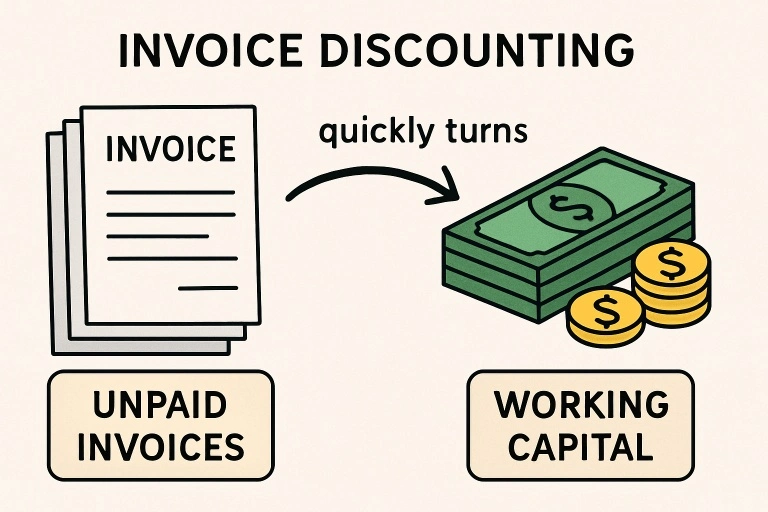Understanding Invoice Discounting
Invoice discounting can be described as an innovative method of financing that allows companies to get cash fast with their unpaid invoicing as collateral. Companies partner with invoice discounting companies to receive a significant portion of the invoice value up front, rather than waiting weeks or
months for customers to pay. This method is especially useful when dealing with long time frames for payment or an enormous quantity of requisitions, providing the company with immediate cash to pay for operational costs.
In contrast to traditional loans that typically require the use of property or other assets for security, the invoice discounting process is based solely on the sales ledger. It is generally private, and your customers are ignorant that you’re using receivables to fund. You have more control over your collections and the absence of a need to alter ownership; this type of financing can be a major game-changer for firms that need to increase flexibility and speed.
Benefits of Invoice Discounting
Improved Cash Flow Management
Through the conversion of receivables to instant money, invoice discounting makes sure that you will have enough cash for urgent expenditures and invest in bulk purchases, or take advantage of unanticipated opportunities. The elimination of long-running waits for payments will dramatically improve stability and increase the strength of the working capital cycle.
Flexibility and Control
Through invoice discounting, the business does not have to depend on restrictive banks or take on resources to fund collateral. It is your choice which invoices to discount while assuming the full accountability for collection and communication with customers, as well as ensuring that your customers’ relationships are maintained and the reputation of your business.
Cost-Effective Alternative
Invoice discounting fees are generally lower than the fees that are charged for other alternatives, for example, credit or overdrafts for business. The amount of funds available increases as your business grows, while you only pay the amount you actually use, which makes it a scalable and affordable option for periods that are expanding.

Encourages Business Growth
Cash flow that is immediate allows for rapid investing in new items, more inventory, and even new ventures. It is possible to take larger or regular orders from clients, leveraging opportunities that would otherwise be unattainable because of the limited cash flow.
Implementing Invoice Discounting in Your Financial Strategy
Evaluate Your Cash Flow Needs
Begin by looking at your company’s balance sheets and payment cycle. Determine when the liquidity is a problem because of slow-paying clients or seasonal fluctuations. Examine the amount and quality of your receivables to assess the extent to which invoice discounting can provide an actual benefit. According to Business News Daily, understanding these cash flow patterns is crucial for selecting the right strategy, whether that involves tightening collections, negotiating more favorable payment terms, or utilizing financing tools like invoice discounting to mitigate revenue gaps.
Choose the Right Provider
Working with an honest and trustworthy provider is vital. You should look for clear fees and flexible terms, as well as expertise in the field, as well as a robust customer service. The transparency of contracts and services creates trust and guarantees your business’s interests remain protected.
Implement Efficient Invoicing Practices
Invoices should be current, accurate, and professional. The clear details regarding payment terms, including contact details, payment terms, and timeframes for collection, speed up the process of approval for discounting and minimize disputes or delays. Effective invoicing results in quicker financing and lower administrative costs.
Monitor and Manage Cash Flow Effectively
Make use of the liquidity gained through discounts on invoices strategically. Utilize forecasting tools, financial dashboards to track what, where, and the amount of money you’re able to access through discounting. Ensure that you have the optimal levels of working capital without exaggerating.
Potential Risks and Considerations
Customer Credit Risk
Discounting of invoices is a common method for establishing the creditworthiness and reliability of your clients. In the event that a client defaults, the business could be in charge of repaying the lender, which could expose you to possible financial losses. Selection of clients with solid payments and running rigorous credit checks is crucial.
Cost Structure
Although often less expensive than loans secured by collateral, invoice discounting can be costly due to service charges and also charges for interest. Companies should be aware of these expenses as well as hidden fees, so that the benefits exceed the costs. Reviewing the terms of several providers as well as using online tools to compare them will help strike the ideal compromise between cost and flexibility.
Operational Demands
While it is simple, the procedure requires some administrative tasks. Invoicing and reconciliation that is well-organized, as well as reporting processes, are vital to ensure the system is in good working order. Firms without a strong financial management structure could encounter difficulties with the process without proper help.
Conclusion
Discounting on invoices can be a potent and flexible finance option for firms looking to maximize the potential value of receivables while not compromising the control or ownership. Through the conversion of unpaid invoices to working capital that is immediately available, firms can improve their liquidity, profit from the opportunities for growth, and work with more confidence in their financial position. Although it is essential to think about aspects like the creditworthiness of the customer, transparency and trustworthiness of providers, as well as the operational capability, an effective invoice discounting technique can be used as an effective and flexible option to ensure the ongoing growth and success of your business.